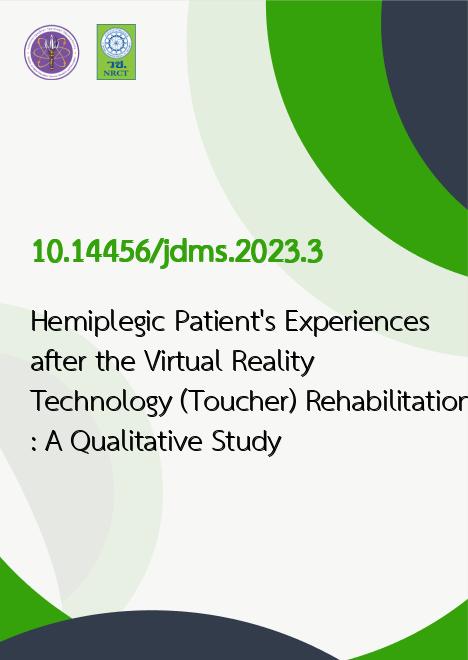
|
Hemiplegic Patient's Experiences after the Virtual Reality Technology (Toucher) Rehabilitation: A Qualitative Study |
|---|---|
| รหัสดีโอไอ | |
| Creator | Chorpaka Longlalerng |
| Title | Hemiplegic Patient's Experiences after the Virtual Reality Technology (Toucher) Rehabilitation: A Qualitative Study |
| Contributor | Saiphon Tospatinrat, Cholticha Pinkaew, Nathawuth Boontha |
| Publisher | สำนักวารสารกรมการแพทย์ |
| Publication Year | 2566 |
| Journal Title | Journal of the Department of Medical Services |
| Journal Vol. | 48 |
| Journal No. | 1 |
| Page no. | 27-34 |
| Keyword | Hemiplegic patient's, Virtual Reality Technology, Rehabilitation |
| URL Website | https://he02.tci-thaijo.org/index.php/JDMS |
| Website title | วารสารกรมการแพทย์ |
| ISSN | 2697-6404 |
| Abstract | Background: Cerebrovascular disease is a major disease that causes disability and patients should berehabilitated. Objective: The aim of this study was to determine hemiplegia patients' experiences after using VirtualReality Technology (Toucher). Methods: The study was a qualitative design that included semi-structured interviews.Ten hemiplegia patients were interviewed after an intervention with Toucher for 3 weeks period in OccupationalTherapy Department at Chiang Mai Neurological Hospital. The responses were analyzed using content analysis. Result: The three main findings of the study are (I) Patients' attitudes regarding applying virtual reality technology forrehabilitation. The technology can help patients improve their affected arm. Virtual reality technology may providemotivation for rehabilitation due to the engaging games, animation, and music. (II) Virtual reality technology couldmake patients be more self-supporting in their daily activities; for example, eating, dressing, and bathing. (III) Hemiplegicpatients' psychical activity and environmental limitations. Activities that they could execute are household choressuch as meal preparing and leisure activities. The appropriate usage of virtual reality technology in rehabilitation is20-30 minutes, 2-3 times per week as a supplement to conventional occupational therapy. Conclusion: Virtual RealityTechnology (Toucher) intervention to encourage and improve the motivation for the rehabilitation of affected armfunction after stroke in order to perform everyday activities and socialization. The result of this study can be used as abasis for technological knowledge that will be successful for rehabilitation in the future with client-centered practices. |